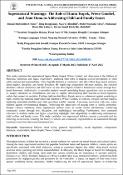Options
Supernatural Warnings: The Role Of Hantu Kopek, Wewe Gombel, And Ame-onna In Addressing Child And Family Issues
Journal
International Journal of Research and Innovation in Social Science
Date Issued
2025
Author(s)
Ahmad Muhyiddin B Yusof
Ding DongLiang
Nasirin Abdullah
Mohamad Hanis Bin Yahaya
Imran Danial Krish Bin Abdullah
DOI
10.47772/IJRISS.2025.90300305
Abstract
This study examines the supernatural figures Hantu Kopek, Wewe Gombel, and Ame-onna in the folklore of Malaysia, Indonesia, and Japan, respectively, analyzing their roles in shaping societal perceptions of child safety and parental responsibility. These legends function as cautionary tales that reflect deep-seated anxieties about neglect, discipline, and family dynamics. By employing comparative literature analysis, this research identifies cultural similarities and differences in how these figures reinforce behavioural norms through fear-based deterrents. Additionally, structuralist analysis reveals underlying binary oppositions such as protection vs. danger, obedience vs. disobedience, and care vs. neglect, demonstrating their function as moral regulators within their respective societies. Findings indicate that Hantu Kopek serves as a deterrent against wandering at night, reinforcing maternal supervision and obedience. Wewe Gombel, in contrast, critiques parental neglect, sheltering mistreated children until their guardians exhibit remorse. Ame-onna, associated with rain, warns children against environmental dangers, reinforcing the importance of staying close to family protection. Despite cultural variations, these supernatural entities serve as social control mechanisms, reinforcing community values through fear, discipline, and mythological storytelling. Furthermore, their continued relevance in modern media and digital storytelling highlights their adaptability in addressing contemporary child welfare and family issues. This study concludes that supernatural folklore remains a powerful tool for enforcing social norms, ensuring that family structures and community responsibilities are maintained through cautionary narratives that transcend generations.
File(s)
Loading...
Name
Supernatural Warnings.pdf
Size
481.45 KB
Format
Adobe PDF
Checksum
(MD5):57737632b9494649c5f744e72fdf4c34